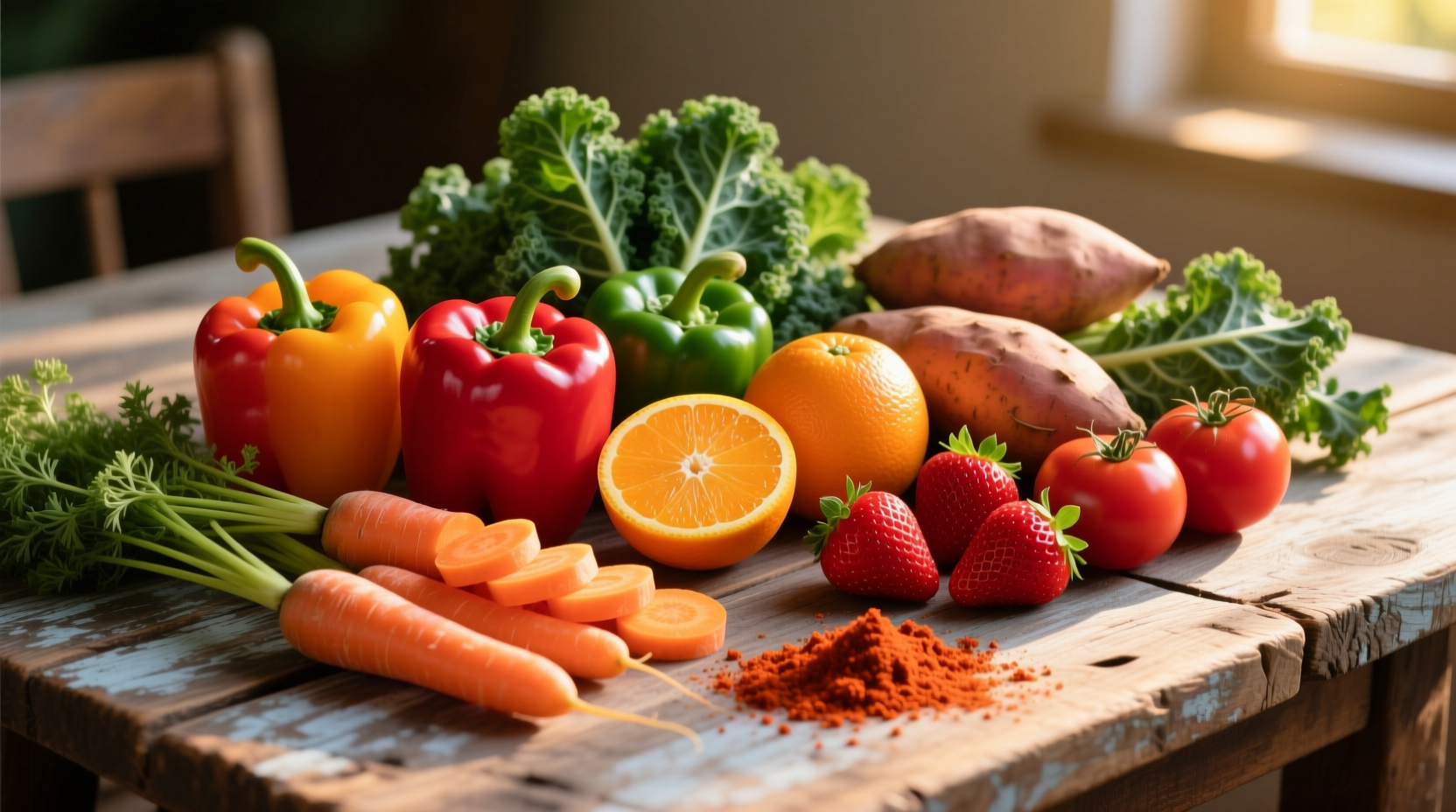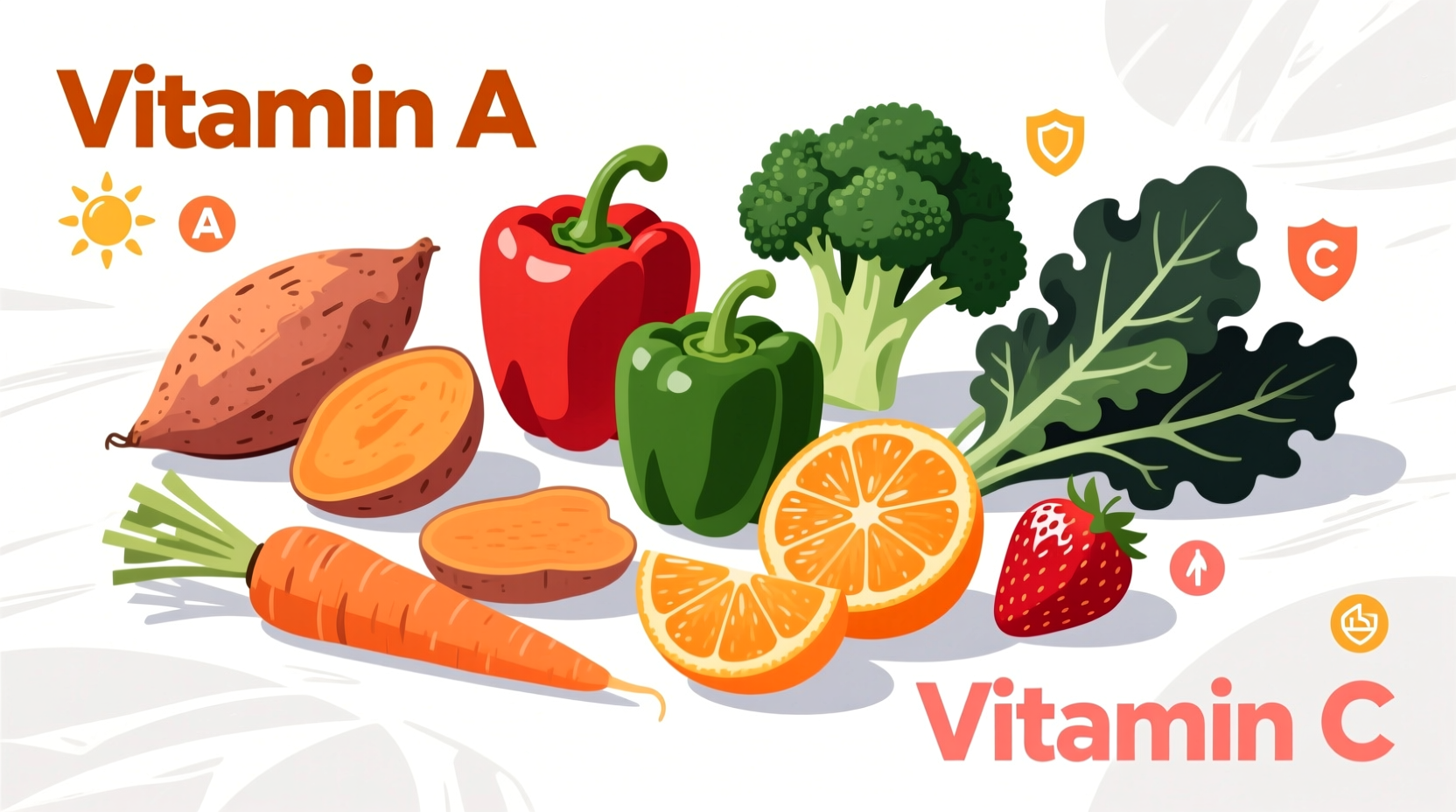The top foods containing both vitamin A and vitamin C include sweet potatoes, carrots, red bell peppers, mangoes, papayas, cantaloupe, broccoli, spinach, and kale. Just one medium sweet potato provides over 400% of your daily vitamin A needs and 37% of vitamin C, while one cup of raw red bell peppers delivers 190% of vitamin C and 19% of vitamin A.
When you're searching for what foods have vitamin a and c together, you're likely looking to boost your immune system, improve skin health, or address specific nutritional gaps. These two powerful vitamins work synergistically—vitamin C enhances the absorption of plant-based vitamin A (beta-carotene), making certain food combinations particularly effective for maximizing nutritional benefits.
Why Vitamin A and C Combination Matters
Vitamin A supports vision, immune function, and skin health, while vitamin C acts as a powerful antioxidant and aids collagen production. When consumed together from whole food sources, they create a nutritional synergy that supplements often can't replicate. Research from the National Institutes of Health shows that the bioavailability of beta-carotene (which converts to vitamin A) increases by up to 30% when paired with vitamin C-rich foods.
Top Food Sources with Both Vitamins
These foods deliver significant amounts of both vitamins per typical serving. All nutritional data comes from the USDA FoodData Central database (2023 values).
| Food | Vitamin A (RAE)* | Vitamin C | Best Eaten |
|---|---|---|---|
| Sweet potato (1 medium, baked) | 1403 μg (156% DV) | 22.3 mg (25% DV) | With olive oil for better absorption |
| Red bell pepper (1 cup, raw) | 159 μg (18% DV) | 190 mg (211% DV) | Raw in salads or roasted |
| Mango (1 cup, sliced) | 112 μg (12% DV) | 60 mg (67% DV) | Fresh, not overripe |
| Papaya (1 cup, cubed) | 150 μg (17% DV) | 88 mg (98% DV) | Ripe with black seeds removed |
| Broccoli (1 cup, cooked) | 31 μg (3% DV) | 102 mg (113% DV) | Lightly steamed |
*RAE = Retinol Activity Equivalents; DV = Daily Value based on 900 μg for vitamin A and 90 mg for vitamin C for adults

Fruit Powerhouses for Daily Vitamin Boost
Certain fruits deliver an exceptional combination of both vitamins. Mangoes stand out as one of the few fruits providing substantial amounts of both nutrients—just one cup gives you nearly two-thirds of your daily vitamin C needs and over 10% of vitamin A. The CDC's National Health and Nutrition Examination Survey shows that mango consumption has increased by 45% in the past decade as people recognize its dual-vitamin benefits.
Papaya offers even more impressive numbers—a single cup provides nearly 100% of your daily vitamin C requirement and a significant amount of beta-carotene. When selecting papayas, choose ones with yellow streaks on the skin for optimal ripeness and nutrient content. The enzyme papain in papaya also enhances nutrient absorption, making it particularly effective for vitamin uptake.
Vegetable Varieties for Maximum Nutrition
Among vegetables, sweet potatoes reign supreme for vitamin A content while still providing meaningful vitamin C. Unlike supplements, the beta-carotene in sweet potatoes converts to vitamin A only as your body needs it, preventing potential toxicity. For maximum benefit, nutritionists recommend pairing sweet potatoes with a small amount of healthy fat like olive oil, which increases carotenoid absorption by up to 50% according to research published in the American Journal of Clinical Nutrition.
Red bell peppers actually contain three times more vitamin C than oranges by weight. Their vitamin A content, while lower than some other options, becomes more bioavailable when the peppers are cooked. A practical tip: roast red peppers and blend them into soups or sauces to create vitamin-rich bases for multiple meals throughout the week.
Practical Integration into Your Diet
Instead of asking what foods have vitamin a and c separately, focus on strategic combinations that maximize absorption. Try these evidence-based approaches:
- Morning boost: Blend spinach (vitamin A) with orange segments (vitamin C) in smoothies—the vitamin C enhances the conversion of spinach's beta-carotene to active vitamin A
- Lunch solution: Create a salad with roasted sweet potato cubes, red bell peppers, and a citrus vinaigrette
- Snack smart: Pair mango slices with a squeeze of lime juice to boost nutrient absorption
Timing matters too. The Harvard T.H. Chan School of Public Health notes that consuming vitamin C-rich foods within the same meal as vitamin A sources can increase carotenoid absorption by 20-30%. This is particularly important for plant-based vitamin A sources (beta-carotene), which have lower natural absorption rates.
Contextual Considerations for Optimal Benefits
While these foods offer tremendous benefits, certain conditions affect their effectiveness. People with cystic fibrosis or Crohn's disease often have difficulty absorbing fat-soluble vitamins like vitamin A, requiring higher intake levels. Pregnant women should monitor vitamin A intake from animal sources (retinol) but can safely consume higher amounts from plant-based beta-carotene sources.
Cooking methods significantly impact nutrient retention. Boiling vegetables can leach up to 50% of vitamin C content, while steaming preserves more nutrients. For carrots specifically, cooking increases beta-carotene availability by breaking down cell walls, but raw consumption preserves more vitamin C. This context helps explain why the question of what foods have vitamin a and c requires nuanced answers beyond simple lists.
Historical Perspective on Vitamin Discovery
Our understanding of these vitamins has evolved significantly. In the early 20th century, scientists identified vitamin A deficiency as the cause of night blindness among prisoners—a discovery that earned Henrik Dam and Edward Doisy the 1943 Nobel Prize. Vitamin C's role in preventing scurvy was recognized even earlier, with James Lind's 1747 experiments showing citrus fruits cured the disease. However, it wasn't until 1932 that vitamin C was isolated and identified as the active compound.
This historical context matters because early research focused on deficiency prevention, while modern nutrition science emphasizes optimal intake for disease prevention and overall wellness. The current Recommended Dietary Allowances (RDAs) reflect this evolution, with higher targets for optimal health rather than just preventing deficiency symptoms.
Measuring Your Vitamin Intake Effectiveness
Simply knowing what foods have vitamin a and c isn't enough—you need to assess whether your current diet meets your needs. The USDA's MyPlate guidelines recommend:
- 2-3 cups of vegetables daily, emphasizing dark leafy greens and orange vegetables
- 1.5-2 cups of fruit daily, with variety in color and type
A practical self-assessment: If you're eating at least three different colored vegetables at dinner (like spinach, carrots, and red peppers), you're likely meeting your dual-vitamin needs. Blood tests remain the most accurate measurement, but consistent consumption of the foods listed above typically ensures adequate levels for most healthy adults.
Frequently Asked Questions
Can you get too much vitamin A from food sources?
Plant-based vitamin A (beta-carotene) from foods like sweet potatoes and carrots is generally safe in large amounts, as your body converts only what it needs. However, excessive animal-based vitamin A (retinol) from liver or supplements can cause toxicity. The upper limit for preformed vitamin A is 3,000 mcg RAE daily for adults.
Which cooking method preserves the most vitamin C?
Steaming preserves the most vitamin C compared to boiling or frying. Microwaving with minimal water also retains high levels. Vitamin C is water-soluble and heat-sensitive, so shorter cooking times at lower temperatures with less water yield the best nutrient retention.
Do frozen fruits and vegetables have the same vitamin content as fresh?
Yes, frozen produce often has comparable or even higher vitamin levels than fresh, as it's typically frozen at peak ripeness. A University of California study found frozen fruits maintained vitamin C levels better than fresh during storage. Both forms count toward your daily vitamin A and C needs.
How much vitamin A and C do I need daily?
Adult women need 700 mcg RAE of vitamin A and 75 mg of vitamin C daily. Adult men need 900 mcg RAE of vitamin A and 90 mg of vitamin C. Pregnant and breastfeeding women have higher requirements. These values represent the minimum to prevent deficiency—many health experts recommend higher intakes for optimal health.











 浙公网安备
33010002000092号
浙公网安备
33010002000092号 浙B2-20120091-4
浙B2-20120091-4